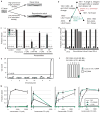Parallel evolution of domesticated Caenorhabditis species targets pheromone receptor genes
- PMID: 21849976
- PMCID: PMC3257054
- DOI: 10.1038/nature10378
Parallel evolution of domesticated Caenorhabditis species targets pheromone receptor genes
Abstract
Evolution can follow predictable genetic trajectories, indicating that discrete environmental shifts can select for reproducible genetic changes. Conspecific individuals are an important feature of an animal's environment, and a potential source of selective pressures. Here we show that adaptation of two Caenorhabditis species to growth at high density, a feature common to domestic environments, occurs by reproducible genetic changes to pheromone receptor genes. Chemical communication through pheromones that accumulate during high-density growth causes young nematode larvae to enter the long-lived but non-reproductive dauer stage. Two strains of Caenorhabditis elegans grown at high density have independently acquired multigenic resistance to pheromone-induced dauer formation. In each strain, resistance to the pheromone ascaroside C3 results from a deletion that disrupts the adjacent chemoreceptor genes serpentine receptor class g (srg)-36 and -37. Through misexpression experiments, we show that these genes encode redundant G-protein-coupled receptors for ascaroside C3. Multigenic resistance to dauer formation has also arisen in high-density cultures of a different nematode species, Caenorhabditis briggsae, resulting in part from deletion of an srg gene paralogous to srg-36 and srg-37. These results demonstrate rapid remodelling of the chemoreceptor repertoire as an adaptation to specific environments, and indicate that parallel changes to a common genetic substrate can affect life-history traits across species.
Figures




Similar articles
-
Ascaroside expression in Caenorhabditis elegans is strongly dependent on diet and developmental stage.PLoS One. 2011 Mar 15;6(3):e17804. doi: 10.1371/journal.pone.0017804. PLoS One. 2011. PMID: 21423575 Free PMC article.
-
[Genetics and evolution of developmental plasticity in the nematode C. elegans: Environmental induction of the dauer stage].Biol Aujourdhui. 2020;214(1-2):45-53. doi: 10.1051/jbio/2020006. Epub 2020 Aug 10. Biol Aujourdhui. 2020. PMID: 32773029 Review. French.
-
A Forward Genetic Screen for Molecules Involved in Pheromone-Induced Dauer Formation in Caenorhabditis elegans.G3 (Bethesda). 2016 May 3;6(5):1475-87. doi: 10.1534/g3.115.026450. G3 (Bethesda). 2016. PMID: 26976437 Free PMC article.
-
Ascaroside activity in Caenorhabditis elegans is highly dependent on chemical structure.Bioorg Med Chem. 2013 Sep 15;21(18):5754-69. doi: 10.1016/j.bmc.2013.07.018. Epub 2013 Jul 18. Bioorg Med Chem. 2013. PMID: 23920482 Free PMC article.
-
Ascaroside Pheromones: Chemical Biology and Pleiotropic Neuronal Functions.Int J Mol Sci. 2019 Aug 9;20(16):3898. doi: 10.3390/ijms20163898. Int J Mol Sci. 2019. PMID: 31405082 Free PMC article. Review.
Cited by
-
Chance and necessity in the evolution of a bacterial pathogen.Nat Genet. 2011 Nov 28;43(12):1174-6. doi: 10.1038/ng.1011. Nat Genet. 2011. PMID: 22120052
-
The dauer hypothesis and the evolution of parasitism: 20 years on and still going strong.Int J Parasitol. 2014 Jan;44(1):1-8. doi: 10.1016/j.ijpara.2013.08.004. Epub 2013 Oct 3. Int J Parasitol. 2014. PMID: 24095839 Free PMC article. Review.
-
Sex-specific, pdfr-1-dependent modulation of pheromone avoidance by food abundance enables flexibility in C. elegans foraging behavior.Curr Biol. 2021 Oct 25;31(20):4449-4461.e4. doi: 10.1016/j.cub.2021.07.069. Epub 2021 Aug 25. Curr Biol. 2021. PMID: 34437843 Free PMC article.
-
The neuroethology of C. elegans escape.Curr Opin Neurobiol. 2012 Apr;22(2):187-93. doi: 10.1016/j.conb.2011.12.007. Epub 2012 Jan 4. Curr Opin Neurobiol. 2012. PMID: 22226513 Free PMC article. Review.
-
Experimental Evolution with Caenorhabditis Nematodes.Genetics. 2017 Jun;206(2):691-716. doi: 10.1534/genetics.115.186288. Genetics. 2017. PMID: 28592504 Free PMC article. Review.
References
Publication types
MeSH terms
Substances
Grants and funding
LinkOut - more resources
Full Text Sources
Other Literature Sources
Molecular Biology Databases
Miscellaneous

